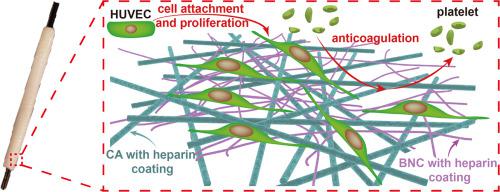Biomaterials Advances ( IF 7.9 ) Pub Date : 2021-01-07 , DOI: 10.1016/j.msec.2020.111861 Quanchao Zhang , Shan He , Xiangbo Zhu , Honglin Luo , Miguel Gama , Mengxia Peng , Xiaoyan Deng , Yizao Wan

|
Constructing biomimetic structure and immobilizing antithrombus factors are two effective methods to ensure rapid endothelialization and long-term anticoagulation for small-diameter vascular grafts. However, few literatures are available regarding simultaneous implementation of these two strategies. Herein, a nano-micro-fibrous biomimetic graft with a heparin coating was prepared via a step-by-step in situ biosynthesis method to improve potential endothelialization and anticoagulation. The 4-mm-diameter tubular graft consists of electrospun cellulose acetate (CA) microfibers and entangled bacterial nanocellulose (BNC) nanofibers with heparin coating on dual fibers. The hybridized and heparinized graft possesses suitable pore structure that facilitates endothelia cells adhesion and proliferation but prevents infiltration of fibrous tissue and blood leakage. In addition, it shows higher mechanical properties than those of bare CA and hybridized CA/BNC grafts, which match well with native blood vessels. Moreover, this dually modified graft exhibits improved blood compatibility and endothelialization over the counterparts without hybridization or heparinization according to the testing results of platelet adhesion, cell morphology, and protein expression of von Willebrand Factor. This novel graft with dual modifications shows promising as a new small-diameter vascular graft. This study provides a guidance for promoting endothelialization and blood compatibility by dual modifications of biomimetic structure and immobilized bioactive molecules.
中文翻译:

静电纺丝管状移植物的肝素化和杂交可改善内皮化和抗凝作用
构建仿生结构和固定抗血栓因子是确保小直径血管移植物快速内皮化和长期抗凝的两种有效方法。但是,关于这两种策略的同时实施的文献很少。在此,用肝素涂层的纳米微纤维仿生接枝制备通过一步一步的原位生物合成方法以改善潜在的内皮化和抗凝作用。直径为4毫米的管状移植物由静电纺丝的醋酸纤维素(CA)超细纤维和缠结的细菌纳米纤维素(BNC)纳米纤维组成,双纤维上具有肝素涂层。杂交和肝素化的移植物具有合适的孔结构,可促进内皮细胞的粘附和增殖,但可防止纤维组织浸润和血液渗漏。此外,它显示出比裸露的CA和杂交的CA / BNC移植物更高的机械性能,与天然血管非常匹配。此外,根据血小板粘附,细胞形态,假性血友病因子的表达和蛋白表达 具有双重修饰的这种新颖的移植物显示出作为新的小直径血管移植物的希望。该研究为通过仿生结构和固定化生物活性分子的双重修饰促进内皮化和血液相容性提供了指导。



























 京公网安备 11010802027423号
京公网安备 11010802027423号